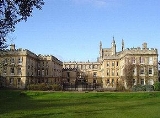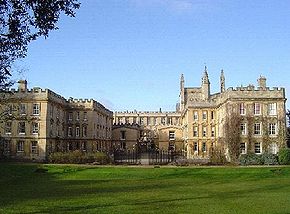
Henry East Havergal
Encyclopedia
Henry East Havergal was a priest in the Church of England
and an organist.
Havergal, eldest son of William Henry Havergal
(1793–1870), was born at Coaley
, Gloucestershire
, 22 July 1820. His mother died in 1848 and his father remarried in 1851. His sister, Frances Ridley Havergal
(1836–1879), became well known as a writer of religious poetry.
 From 1828 to 1834 he served as a chorister in New College, Oxford
From 1828 to 1834 he served as a chorister in New College, Oxford
, and was bible-clerk there from 1839. He matriculated from Magdalen Hall on 18 May 1839, graduating B.A. 1843 and M.A. 1846. In 1843, he became chaplain of Christ Church
, and served in a like capacity at New College from 1844 to 1847. From 1847 till his death, he was vicar
of Cople
, Bedfordshire
.
Also in 1847, he married, on 16 September, Frances Mary, eldest daughter of George J. A. Walker.
For his church at Cople, he built an organ
with his own hands, which possessed the peculiarity that it was an F
organ, that being the note to which the ordinary compass of the human voice extends. On this instrument, he carried out many experiments, and regularly acted as organist. He further constructed a chiming apparatus, and was in the habit of chiming the bells himself before service. For some time, he was the conductor of a musical society at Bedford
.
He possessed a natural alto
voice, and in a trial of William Crotch
's oratorio Palestine he played the double-bass and sang the alto part in the choruses at the same time. He was also a performer on the trumpet
. He died of apoplexy
at Cople vicarage on 12 January 1875, aged 54.
Also Te Deums, hymns, and songs.
Church of England
The Church of England is the officially established Christian church in England and the Mother Church of the worldwide Anglican Communion. The church considers itself within the tradition of Western Christianity and dates its formal establishment principally to the mission to England by St...
and an organist.
Havergal, eldest son of William Henry Havergal
William Henry Havergal
William Henry Havergal was an Anglican clergyman, writer, composer and hymnwriter, and a publisher of sermons and pamphlets...
(1793–1870), was born at Coaley
Coaley
Coaley is a village in the English county of Gloucestershire roughly 4 miles from the town of Dursley, and 5 miles from the town of Stroud. The village drops from the edge of the Cotswold Hills, overlooked by Frocester Hill and Coaley Peak picnic site, towards the River Cam at Cam and Cambridge and...
, Gloucestershire
Gloucestershire
Gloucestershire is a county in South West England. The county comprises part of the Cotswold Hills, part of the flat fertile valley of the River Severn, and the entire Forest of Dean....
, 22 July 1820. His mother died in 1848 and his father remarried in 1851. His sister, Frances Ridley Havergal
Frances Ridley Havergal
Frances Ridley Havergal was an English religious poet and hymn writer. Take My Life and Let it Be and Thy Life for Me are two of her best known hymns. She also wrote hymn melodies, religious tracts, and works for children.-Life:She was born into an Anglican family, at Astley in Worcestershire...
(1836–1879), became well known as a writer of religious poetry.

New College, Oxford
New College is one of the constituent colleges of the University of Oxford in the United Kingdom.- Overview :The College's official name, College of St Mary, is the same as that of the older Oriel College; hence, it has been referred to as the "New College of St Mary", and is now almost always...
, and was bible-clerk there from 1839. He matriculated from Magdalen Hall on 18 May 1839, graduating B.A. 1843 and M.A. 1846. In 1843, he became chaplain of Christ Church
Christ Church, Oxford
Christ Church or house of Christ, and thus sometimes known as The House), is one of the largest constituent colleges of the University of Oxford in England...
, and served in a like capacity at New College from 1844 to 1847. From 1847 till his death, he was vicar
Vicar
In the broadest sense, a vicar is a representative, deputy or substitute; anyone acting "in the person of" or agent for a superior . In this sense, the title is comparable to lieutenant...
of Cople
Cople
Cople is a village and civil parish in the English county of Bedfordshire. The name Cople is derived from the phrase Cock Pool, a place where chickens were kept, that was mentioned in the Domesday Book.- History :...
, Bedfordshire
Bedfordshire
Bedfordshire is a ceremonial county of historic origin in England that forms part of the East of England region.It borders Cambridgeshire to the north-east, Northamptonshire to the north, Buckinghamshire to the west and Hertfordshire to the south-east....
.
Also in 1847, he married, on 16 September, Frances Mary, eldest daughter of George J. A. Walker.
For his church at Cople, he built an organ
Pipe organ
The pipe organ is a musical instrument that produces sound by driving pressurized air through pipes selected via a keyboard. Because each organ pipe produces a single pitch, the pipes are provided in sets called ranks, each of which has a common timbre and volume throughout the keyboard compass...
with his own hands, which possessed the peculiarity that it was an F
F (musical note)
F is a musical note, the fourth above C. It is also known as fa in fixed-do solfège.When calculated in equal temperament with a reference of A above middle C as 440 Hz, the frequency of Middle F is approximately 349.228 Hz. See pitch for a discussion of historical variations in...
organ, that being the note to which the ordinary compass of the human voice extends. On this instrument, he carried out many experiments, and regularly acted as organist. He further constructed a chiming apparatus, and was in the habit of chiming the bells himself before service. For some time, he was the conductor of a musical society at Bedford
Bedford
Bedford is the county town of Bedfordshire, in the East of England. It is a large town and the administrative centre for the wider Borough of Bedford. According to the former Bedfordshire County Council's estimates, the town had a population of 79,190 in mid 2005, with 19,720 in the adjacent town...
.
He possessed a natural alto
Alto
Alto is a musical term, derived from the Latin word altus, meaning "high" in Italian, that has several possible interpretations.When designating instruments, "alto" frequently refers to a member of an instrumental family that has the second highest range, below that of the treble or soprano. Hence,...
voice, and in a trial of William Crotch
William Crotch
William Crotch was an English composer, organist and artist.Born in Norwich to a master carpenter he showed early musical talent . The three and a half year old Master William Crotch was taken to London by his ambitious mother, where he not only played on the organ of the Chapel Royal in St....
's oratorio Palestine he played the double-bass and sang the alto part in the choruses at the same time. He was also a performer on the trumpet
Trumpet
The trumpet is the musical instrument with the highest register in the brass family. Trumpets are among the oldest musical instruments, dating back to at least 1500 BCE. They are played by blowing air through closed lips, producing a "buzzing" sound which starts a standing wave vibration in the air...
. He died of apoplexy
Apoplexy
Apoplexy is a medical term, which can be used to describe 'bleeding' in a stroke . Without further specification, it is rather outdated in use. Today it is used only for specific conditions, such as pituitary apoplexy and ovarian apoplexy. In common speech, it is used non-medically to mean a state...
at Cople vicarage on 12 January 1875, aged 54.
Musical publications
- ‘A Selection from the Hymns and Songs of the Church by George Wither,’ 1846.
- ‘The Preces and Litany of T. Tallis, to which is added a Short Form of Chanting the Preces and Litany,’ 1847; never before printed.
- ‘Christmas Carols for one or more Voices,’ 1850.
- ‘Hymn for Advent—Dies Iræ,’ by W. J. Irons; the music by H. E. Havergal, 1854.
- ‘Tunes, Chants and Responses,’ 1865.
- ‘Hymn Tunes, part i. Original, part ii. Harmonised and Selected,’ 1866.
- ‘Forty-two Chants, each combining two principal Melodies,’ 1870
Also Te Deums, hymns, and songs.

